Rarely do I get to go to an event with graphic recording as my primary duty. It is often an “extra” that I include in my facilitation practice. This year I was invited to the 7th Annual GFRAS Meeting in Limbe, Cameroon as their graphic recorder! Because it is a huge investment of resources – theirs and mine – I asked if I could also run a short “introduction to graphic recording” the before the event kicked off, and then we could have the participants fan out across the breakouts and field trips to capture sketch notes. I can’t be everywhere at once so this gave us some immediate practical coverage, but more importantly, I wanted people to see that this is an accessible, practical and usable practice. This first post is about the workshop itself. Part 2 will share a few stories from the workshop participants about their sketchnoting at the meeting and after they returned home. How are they using their new skills? Part 3 will share the graphic recordings I did with a little reflection on my own process. At the bottom of this post are links to other visual artifacts from the week in Cameroon.
The Workshop
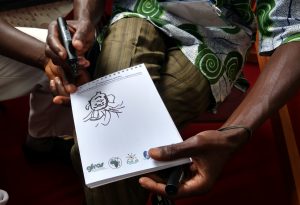 What can you do in just under four hours to help people master the basics of graphic recording? It turns out, you can do quite a lot. I love starting with the fabulous paired drawing activity I learned from Johnnie Moore. In the debrief it always raises so many useful aspects about how we pay attention to and communicate with each other. It creates some fun and some comfort with taking risks. And drawing for and in front of people can be a huge risk for many of us.
What can you do in just under four hours to help people master the basics of graphic recording? It turns out, you can do quite a lot. I love starting with the fabulous paired drawing activity I learned from Johnnie Moore. In the debrief it always raises so many useful aspects about how we pay attention to and communicate with each other. It creates some fun and some comfort with taking risks. And drawing for and in front of people can be a huge risk for many of us.
Then we got into the practice immediately. My graphic recording and graphic facilitation workshops (short or long) always start with liberating our inner artist using an exercise I learned from the fabulous people at the International Forum of Visual Practitioners (I took their GR 101 course years ago!).
The “I Can Draw” 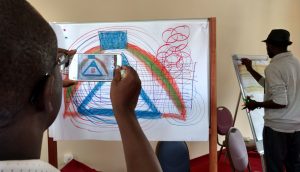 exercise introduces people to simple, body-based ways to draw circles, lines, use color, write clearly and, for extra fun, how using different materials can change and bring a sketch to life (yay chalk and pastels!) It never ceases to amaze me how such beautiful creations emerge, and how empowering this is. The exercise also loosens people’s bodies up to use bolder strokes, bigger lettering and to explore how color can change a visual experience with very little effort.
exercise introduces people to simple, body-based ways to draw circles, lines, use color, write clearly and, for extra fun, how using different materials can change and bring a sketch to life (yay chalk and pastels!) It never ceases to amaze me how such beautiful creations emerge, and how empowering this is. The exercise also loosens people’s bodies up to use bolder strokes, bigger lettering and to explore how color can change a visual experience with very little effort.
 Next we dug into specific skills of drawing people, icons, metaphors and ways to arrange images on one’s paper or note-pad. Because all the work I do with communities, agriculture, development and such, EVERYTHING I work with involves people. And it STILL intimidates me to draw people. We face this head on with simple ways to draw people. Stick figures. Bean people. Star people. Spring people. I loved how Merida immediately riffed on her people to integrate them into the sustainability work she is doing. WINDMILL people!
Next we dug into specific skills of drawing people, icons, metaphors and ways to arrange images on one’s paper or note-pad. Because all the work I do with communities, agriculture, development and such, EVERYTHING I work with involves people. And it STILL intimidates me to draw people. We face this head on with simple ways to draw people. Stick figures. Bean people. Star people. Spring people. I loved how Merida immediately riffed on her people to integrate them into the sustainability work she is doing. WINDMILL people!
 By now people were getting excited, so this is when we started playing with icons, particularly icons that relate to their work, world or context. I have a card deck of silly icons I made years ago. I asked everyone to grab one that they attracted them, and then sketch that icon a number of times to build some comfort. People observed each others’ drawings, swaped cards and iterated. I encouraged people to take pictures of icons – theirs or others’ – that resonated for them. This is so often a practice of “see, imitate, iterate and THEN evolve one’s own style”. Some people have a style right away, like Raj. You can see it in the first sketch note he produced the afternoon after the workshop.
By now people were getting excited, so this is when we started playing with icons, particularly icons that relate to their work, world or context. I have a card deck of silly icons I made years ago. I asked everyone to grab one that they attracted them, and then sketch that icon a number of times to build some comfort. People observed each others’ drawings, swaped cards and iterated. I encouraged people to take pictures of icons – theirs or others’ – that resonated for them. This is so often a practice of “see, imitate, iterate and THEN evolve one’s own style”. Some people have a style right away, like Raj. You can see it in the first sketch note he produced the afternoon after the workshop.
Finally, we put everything together and I challenged everyone to graphically record a short talk I improvise on the spot about preparing to graphically record. Granted, I talked slower, repeated things and even offer a few hints, but really trying to graphically record real time for the first time is VERY HARD. It challenges us to a) listen deeply and carefully, b) identify what points are important and should be captured, and finally, c) actually draw them on the paper. The group did amazingly well for such a short introduction. Afterwards we toured each of the examples, identified strenghts and looked for something new for them to try the “next time!”
Here are some examples of their work. Click to see larger images.
- All my Cameroon Photos: https://goo.gl/photos/5PypHdrdehCU3NBp8
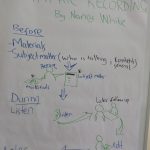

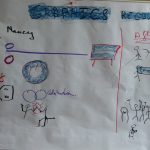
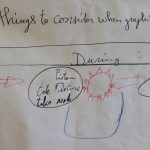
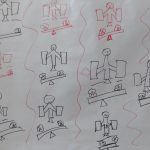
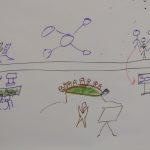
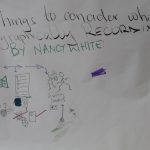
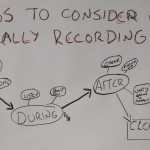


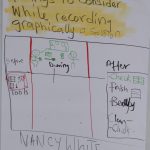
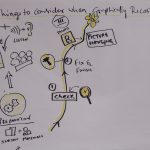
One thought on “Can we learn graphic recording in 4 hours and actually DO something? YES! Part 1”
Comments are closed.